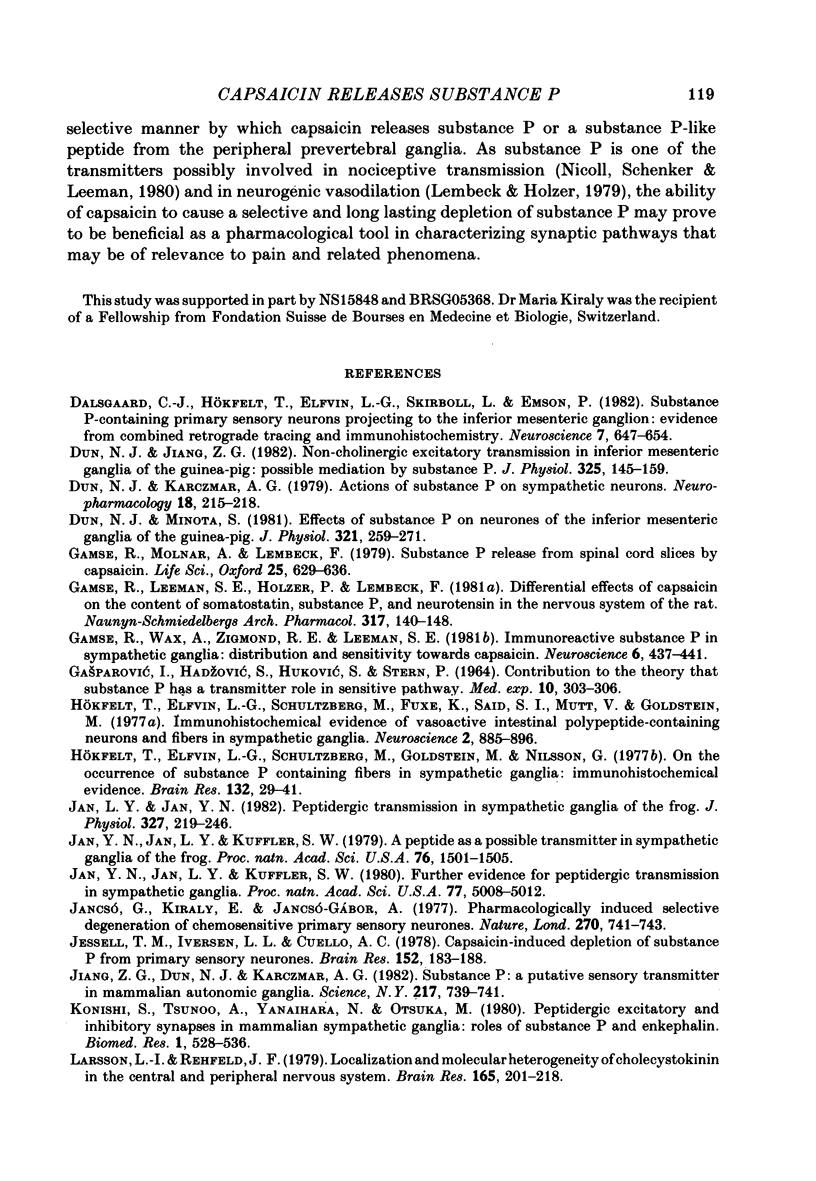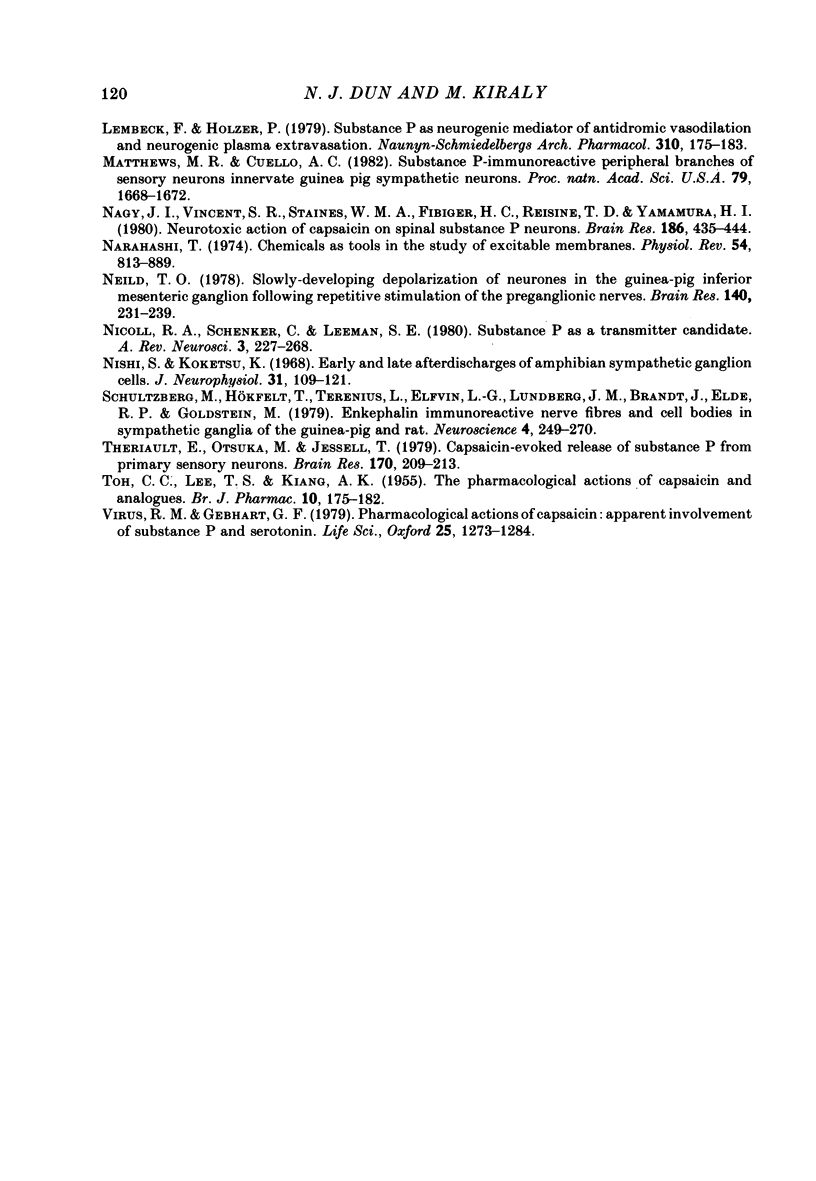Abstract
The effects of capsaicin (0.5-100 microM) on neurones of the isolated inferior mesenteric ganglia (i.m.g.) of the guinea-pig were investigated by means of intracellular recording techniques. When applied to neurones of the i.m.g. that exhibited a slow non-cholinergic excitatory potential (Dun & Jiang, 1982), capsaicin caused in the large majority of these cells a long lasting depolarization accompanied by intense neuronal discharges. During and immediately following the depolarization, repetitive presynaptic stimulation consistently failed to elicit the non-cholinergic depolarization; a partial recovery was observed in relatively few neurones. The fast (nicotinic) excitatory post-synaptic potentials (e.p.s.p.s) were not suppressed by capsaicin in any of these cells. The membrane potential, input resistance and the amplitude of fast e.p.s.p.s in neurones of the i.m.g. that generated no detectable non-cholinergic depolarizations were not affected by capsaicin. Post-synaptic membrane sensitivity to exogenous application of substance P was not altered following capsaicin superfusion even though the latter effectively abolished the non-cholinergic depolarization in the same neurones. Superfusing the i.m.g. with a Ca-free Krebs solution markedly attenuated or abolished the depolarizing effect of capsaicin whereas tetrodotoxin (1 microM) was without effect. Capsaicin was without effect in a few neurones that generated a non-cholinergic depolarization; the latter was not desensitized by bath application of substance P. Capsaicin caused no appreciable effects in neurones of the bullfrog sympathetic ganglia; thus, the fast and slow post-synaptic potentials including the late slow e.p.s.p. the transmitter of which is the peptide luteinizing hormone-releasing hormone (Jan & Jan, 1982) were not affected. The results suggest that the depolarizing effect of capsaicin in neurones of the guinea-pig i.m.g. is due to a selective release of ganglionic substance P or a substance P-like peptide in a Ca-dependent manner, and that the non-cholinergic potentials elicited in capsaicin-insensitive neurones may be generated by a transmitter(s) other than substance P.
Full text
PDF













Selected References
These references are in PubMed. This may not be the complete list of references from this article.
- Dalsgaard C. J., Hökfelt T., Elfvin L. G., Skirboll L., Emson P. Substance P-containing primary sensory neurons projecting to the inferior mesenteric ganglion: evidence from combined retrograde tracing and immunohistochemistry. Neuroscience. 1982 Mar;7(3):647–654. doi: 10.1016/0306-4522(82)90070-7. [DOI] [PubMed] [Google Scholar]
- Dun N. J., Jiang Z. G. Non-cholinergic excitatory transmission in inferior mesenteric ganglia of the guinea-pig: possible mediation by substance P. J Physiol. 1982 Apr;325:145–159. doi: 10.1113/jphysiol.1982.sp014141. [DOI] [PMC free article] [PubMed] [Google Scholar]
- Dun N. J., Karczmar A. G. Actions of substance P on sympathetic neurons. Neuropharmacology. 1979 Feb;18(2):215–218. doi: 10.1016/0028-3908(79)90064-9. [DOI] [PubMed] [Google Scholar]
- Dun N. J., Minota S. Effects of substance P on neurones of the inferior mesenteric ganglia of the guinea-pig. J Physiol. 1981 Dec;321:259–271. doi: 10.1113/jphysiol.1981.sp013982. [DOI] [PMC free article] [PubMed] [Google Scholar]
- GASPAROVIC I., HADZOVIC S., HUKOVIC S., STERN P. CONTRIBUTION TO THE THEORY THAT SUBSTANCE P HAS A TRANSMITTER ROLE IN SENSITIVE PATHWAY. Med Exp Int J Exp Med. 1964;10:303–306. [PubMed] [Google Scholar]
- Gamse R., Leeman S. E., Holzer P., Lembeck F. Differential effects of capsaicin on the content of somatostatin, substance P, and neurotensin in the nervous system of the rat. Naunyn Schmiedebergs Arch Pharmacol. 1981 Sep;317(2):140–148. doi: 10.1007/BF00500070. [DOI] [PubMed] [Google Scholar]
- Gamse R., Molnar A., Lembeck F. Substance P release from spinal cord slices by capsaicin. Life Sci. 1979 Aug 13;25(7):629–636. doi: 10.1016/0024-3205(79)90558-7. [DOI] [PubMed] [Google Scholar]
- Gamse R., Wax A., Zigmond R. E., Leeman S. E. Immunoreactive substance P in sympathetic ganglia: distribution and sensitivity towards capsaicin. Neuroscience. 1981;6(3):437–441. doi: 10.1016/0306-4522(81)90136-6. [DOI] [PubMed] [Google Scholar]
- Hökfelt T., Elfvin L. G., Schultzberg M., Goldstein M., Nilsson G. On the occurrence of substance P-containing fibers in sympathetic ganglia: immunohistochemical evidence. Brain Res. 1977 Aug 19;132(1):29–41. doi: 10.1016/0006-8993(77)90704-1. [DOI] [PubMed] [Google Scholar]
- Jan L. Y., Jan Y. N. Peptidergic transmission in sympathetic ganglia of the frog. J Physiol. 1982 Jun;327:219–246. doi: 10.1113/jphysiol.1982.sp014228. [DOI] [PMC free article] [PubMed] [Google Scholar]
- Jan Y. N., Jan L. Y., Kuffler S. W. A peptide as a possible transmitter in sympathetic ganglia of the frog. Proc Natl Acad Sci U S A. 1979 Mar;76(3):1501–1505. doi: 10.1073/pnas.76.3.1501. [DOI] [PMC free article] [PubMed] [Google Scholar]
- Jan Y. N., Jan L. Y., Kuffler S. W. Further evidence for peptidergic transmission in sympathetic ganglia. Proc Natl Acad Sci U S A. 1980 Aug;77(8):5008–5012. doi: 10.1073/pnas.77.8.5008. [DOI] [PMC free article] [PubMed] [Google Scholar]
- Jancsó G., Kiraly E., Jancsó-Gábor A. Pharmacologically induced selective degeneration of chemosensitive primary sensory neurones. Nature. 1977 Dec 22;270(5639):741–743. doi: 10.1038/270741a0. [DOI] [PubMed] [Google Scholar]
- Jessell T. M., Iversen L. L., Cuello A. C. Capsaicin-induced depletion of substance P from primary sensory neurones. Brain Res. 1978 Aug 18;152(1):183–188. doi: 10.1016/0006-8993(78)90146-4. [DOI] [PubMed] [Google Scholar]
- Jiang Z., Dun N. J., Karczmar A. G. Substance P: a putative sensory transmitter in mammalian autonomic ganglia. Science. 1982 Aug 20;217(4561):739–741. doi: 10.1126/science.6179162. [DOI] [PubMed] [Google Scholar]
- Larsson L. I., Rehfeld J. F. Localization and molecular heterogeneity of cholecystokinin in the central and peripheral nervous system. Brain Res. 1979 Apr 13;165(2):201–218. doi: 10.1016/0006-8993(79)90554-7. [DOI] [PubMed] [Google Scholar]
- Lembeck F., Holzer P. Substance P as neurogenic mediator of antidromic vasodilation and neurogenic plasma extravasation. Naunyn Schmiedebergs Arch Pharmacol. 1979 Dec;310(2):175–183. doi: 10.1007/BF00500282. [DOI] [PubMed] [Google Scholar]
- Matthews M. R., Cuello A. C. Substance P-immunoreactive peripheral branches of sensory neurons innervate guinea pig sympathetic neurons. Proc Natl Acad Sci U S A. 1982 Mar;79(5):1668–1672. doi: 10.1073/pnas.79.5.1668. [DOI] [PMC free article] [PubMed] [Google Scholar]
- Nagy J. I., Vincent S. R., Staines W. A., Fibiger H. C., Reisine T. D., Yamamura H. I. Neurotoxic action of capsaicin on spinal substance P neurons. Brain Res. 1980 Mar 31;186(2):435–444. doi: 10.1016/0006-8993(80)90987-7. [DOI] [PubMed] [Google Scholar]
- Narahashi T. Chemicals as tools in the study of excitable membranes. Physiol Rev. 1974 Oct;54(4):813–889. doi: 10.1152/physrev.1974.54.4.813. [DOI] [PubMed] [Google Scholar]
- Neild T. O. Slowly-developing depolarization of neurones in the guinea-pig inferior mesenteric ganglion following repetitive stimulation of the preganglionic nerves. Brain Res. 1978 Jan 27;140(2):231–239. doi: 10.1016/0006-8993(78)90457-2. [DOI] [PubMed] [Google Scholar]
- Nicoll R. A., Schenker C., Leeman S. E. Substance P as a transmitter candidate. Annu Rev Neurosci. 1980;3:227–268. doi: 10.1146/annurev.ne.03.030180.001303. [DOI] [PubMed] [Google Scholar]
- Nishi S., Koketsu K. Early and late after discharges of amphibian sympathetic ganglion cells. J Neurophysiol. 1968 Jan;31(1):109–121. doi: 10.1152/jn.1968.31.1.109. [DOI] [PubMed] [Google Scholar]
- Schultzberg M., Hökfelt T., Terenius L., Elfvin L. G., Lundberg J. M., Brandt J., Elde R. P., Goldstein M. Enkephalin immunoreactive nerve fibres and cell bodies in sympathetic ganglia of the guinea-pig and rat. Neuroscience. 1979;4(2):249–270. doi: 10.1016/0306-4522(79)90087-3. [DOI] [PubMed] [Google Scholar]
- TOH C. C., LEE T. S., KIANG A. K. The pharmacological actions of capsaicin and analogues. Br J Pharmacol Chemother. 1955 Jun;10(2):175–182. doi: 10.1111/j.1476-5381.1955.tb00079.x. [DOI] [PMC free article] [PubMed] [Google Scholar]
- Theriault E., Otsuka M., Jessell T. Capsaicin-evoked release of substance P from primary sensory neurons. Brain Res. 1979 Jul 6;170(1):209–213. doi: 10.1016/0006-8993(79)90957-0. [DOI] [PubMed] [Google Scholar]
- Virus R. M., Gebhart G. F. Pharmacologic actions of capsaicin: apparent involvement of substance P and serotonin. Life Sci. 1979 Oct 8;25(15):1273–1283. doi: 10.1016/0024-3205(79)90392-8. [DOI] [PubMed] [Google Scholar]


